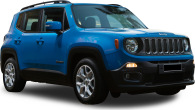Remember when most brands made wagon versions of popular hatchbacks?
That trend more or less continues to this day but instead of stretching out a hatchback and giving it a bigger boot, manufacturers now focus on lifting its ride height, slapping some extra plastic panelwork on, maybe even add all-wheel drive, and call it an SUV.
The benefits are obvious, one set of components and powertrains gives a brand like Toyota access to two different buyers, in two different demographics, in two separate price points.

Enter, then, Toyota’s latest hatch-based-SUV venture, the Yaris Cross. As the name suggests, it’s a small SUV based on the brand’s pricey but well specified new-generation Yaris hatchback.
Should it woo buyers from the established small SUV crowd? We’ve driven both flavours – hybrid and non-hybrid – to find out.

Toyota Yaris Cross 2021: Urban Cross
| Engine Type | Inline 3, 1.5L |
|---|---|
| Fuel Type | Unleaded Petrol |
| Fuel Efficiency | 5.4L/100km (combined) |
| Seating | 5 |
| Price From | $28,930 - $34,870 |
| Safety Rating |
|
Does it represent good value for the price? What features does it come with?
8 / 10
There are nine possible permutations of Yaris Cross which sounds like a lot, but it’s easy to make heads or tails of when you break it down into powertrains and spec levels.
There are three grades of the Yaris Cross: GX, GXL, and the top-spec Urban, and these are available in either petrol front-wheel drive, hybrid front-wheel drive, or hybrid all-wheel drive.
All-wheel drive availability is a boost, but the manual from the hatchback range doesn’t carry across, so there’s a trade-off there.

Pricing-wise the Yaris Cross ranges from $26,990 for the base front-wheel drive petrol GX to a pricey $37,990 for the top-spec Urban hybrid AWD.
You’ll notice the pricing is only a few thousand dollars more spec-for-spec than the controversially priced Yaris hatch on which it is based. It also means that it is much more price competitive than its hatch sibling, as this mid-$30K region is more acceptable for the small SUV scene.
This also makes its rivals the Mazda CX-3 ($22,710 - $38,450), Subaru XV ($29,240 - $35,580), VW T-Cross ($27,990 - $30,990), and new Ford Puma ($29,990 - $35,540).
You may also consider the Hyundai Venue at the more affordable end of the spectrum ($20,190 - $25,990), as it is in the same size bracket.
Equipment levels are good, with even the base GX scoring 16-inch alloys, single-zone climate control, keyless entry and push-start, and a 7.0-inch multimedia touchscreen with Apple CarPlay and Android Auto.

The GXL adds LED headlights, blind spot monitoring, built-in sat-nav and the ‘panoramic’ rear view camera, while the Urban grade we tested also gains things like heated front seats, an electrically adjustable driver’s seat, 18-inch alloy wheels, a holographic head-up display and a motorised tailgate with gesture control.
Oddly though, the Yaris Cross doesn’t get too many advanced connectivity things which some rivals gain, like wireless charging, wireless CarPlay or Android Auto, and no USB-C. Also, there’s no larger screen for higher grades, with the 7.0-inch one across the range looking a bit small in today’s era.
There are also no higher-end trims for the interior. Our top-spec test cars had cloth interior trims and hard plastic highlights, which don’t compare particularly well to higher-grade leather-trimmed versions of the Mazda CX-3 and Subaru XV.

One of the biggest value adds for Toyota is its hybrid drive system, which will inevitably draw buyers in over rivals for its easy fuel efficiency gains, especially since a base Yaris Cross GX hybrid AWD at $31,990 is a great value proposition against its only real competition here, the entry-level Subaru XV Hybrid-L ($35,490).
Key active safety items are standard, too, which is a big win for buyers. Check out more on that in the safety section of this review.
Is there anything interesting about its design?
7 / 10
The most interesting thing about this car’s design is how different Toyota has managed to make the Yaris Cross from the outside, despite sharing so much with its hatchback donor car.
The Yaris Cross cuts a much tougher silhouette, with its squared off roofline, angular and upright bonnet, and much larger alloy wheels filling those now massive wheelarches, compared to the curves and finer details of the hatch.

It’s controversial though. The office was divided on whether they liked the look of this car. You have to give Toyota full points for not just lifting up the Yaris hatch, though. Despite its name, the Yaris Cross looks very much its own product compared to the CX-3 or XV, wouldn’t you agree?
There are elements of RAV4 in the lights or rear three-quarter, but a unique side profile and front profile give the Yaris Cross a touch of urban attitude.

Inside is mostly just Yaris hatch. The same dash claddings, the same wheel and instrument design, and the same touchpoints exist, even the weird plastic texture in the door cards.
As a touchpoint the wheel is nice, the semi-digital dial-cluster is downright cool, and I appreciate the mix of materials and textures in the door design. Little elements like the pinstripe which runs across the dash into the doors is great attention to detail.

I’m less a fan of the basic seat trims which had an awful brown on ‘80s carpet design on both our test cars, and the abundance of hard, hollow plastics everywhere else.
Tough ask for a car in this price bracket, and higher-end versions of the XV and CX-3 have more plush interiors.
How practical is the space inside?
7 / 10
You’d think the Yaris Cross, being an SUV, would be inherently more practical, right? Let’s take a look.
The extra ride height, which is why small SUVs are largely purchased, is welcome. This car will be better than your average hatchback on gravel roads, and it’s more comfortable to get in and out of if you’re not in the habit of bending down often.
However, one benefit of SUV practicality is often pitched as the ease of fitting child seats in the back.
That can’t be the case in the Yaris Cross, because the rear doors barely open far enough for easy adult entry and egress, let alone fitting a child seat! The rear seat trims are basic, too, although the roofline and larger rear windows make for a less claustrophobic feel in the back seat compared to the Yaris hatch.

There are still no rear air vents regardless of spec, and there are also no rear power outlets for charging. Rear occupants get one pocket on the back of the front passenger seat, and medium-size bottle holders in the doors.
I fit behind my own driving position comfortably, with a reasonable gap for my knees. I’m 182cm (6'0") tall. All three seats are in a split-folding arrangement, so you can drop the centre down separately to be used as a ski port. It also has two cupholders.

Then there’s boot space. The idea that SUVs have larger boots than hatches or sedans is often more myth than reality, but the Yaris Cross offers 390 litres (VDA) in 2WD form, or 314L in hybrid form, which is a significant upgrade on the hatchback.

It’s also pretty good for the small SUV class outdoing both the XV and CX-3. For context it would also be good for the mid-size hatch segment. A false floor helps to provide a level surface with the rather tall aperture if need be.

Front passengers are treated better. There’s quite a bit more room on offer, plus the tall roofline and adjustable seats should render it comfortable for most.

The hard trims on the doors and dash are a letdown, especially for your knees and elbows, and there isn’t a centre console armrest to lift the ambiance or comfort.
Storage comes from three cupholders on the transmission tunnel, a large binnacle under the climate controls, some decent door bins with bottle holders, and some extra nooks and crannies cut out of the dash.

What’s odd, though, is none of these surfaces are rubberised, making them precarious for storing objects while on the move.
I also like how easy the climate controls and screen is to reach with both having easy adjustable dials and the screen having tactile shortcut buttons.
Some extra practicality boosts that higher-spec Yaris Crosses get over the Yaris hatch include electrically adjustable front seats, and a powered tailgate with gesture control.
What are the key stats for the engine and transmission?
7 / 10
All three Yaris Cross powertrains have Toyota’s new 1.5-litre three-cylinder petrol engine shared with the Yaris hatch.
This engine produces a reasonable 88kW/145Nm in non-hybrid guise and drives the front-wheels only via a continuously variable automatic transmission.

Meanwhile hybrid variants pair a de-specified version of this engine with electric motors for a what Toyota calls a combined output of 85kW.
All-wheel drive versions of the Yaris Cross are interesting as they use only an electric motor to drive the rear wheels. Toyota says up to 60 percent of electric torque can be driven to the rear axle in this configuration.

How much fuel does it consume?
8 / 10
The sticker on hybrid variants of the Yaris Cross is an impressively low 3.8L/100km. I was happy to find that over a few hundred clicks, our test Urban hybrid all-wheel drive produced a reasonable 5.2L/100km.

It’s important to note that this real-world figure demonstrates much better hybrid value than the equivalent XV hybrid grades.
The non-hybrid versions aren't quite as miserly, with our Urban-spec test car producing a dash-reported 7.5L/100km over similar driving conditions.

The Yaris Cross will happily drink base 91RON unleaded fuel and has a 42-litre tank in the non-hybrid or 36L tank in hybrid variants.
Warranty & Safety Rating
What safety equipment is fitted? What safety rating?
9 / 10
Even the base Yaris Cross scores the important big-ticket active safety items, featuring the latest version of Toyota’s auto emergency braking (AEB – detects pedestrians and cyclists – works on cross traffic intersections and at night), lane keep assist with lane departure warning, and adaptive cruise control. The GXL and Urban score blind spot monitoring, too.

It also has a complement of eight airbags, including two between the front passengers and, in a first for Toyota in Australia, an SOS function which can call an emergency centre at the press of a button or automatically in the event of airbag deployment.
The Yaris Cross was yet to be assessed by ANCAP at the time of writing, but as EuroNCAP hailed its hatch sibling as “the benchmark for small car safety” we won’t be surprised to see the Yaris Cross score well across the board.

What does it cost to own? What warranty is offered?
8 / 10
As with all current Toyotas, the Yaris Cross is covered by a five-year, unlimited kilometre warranty, on-par for the mainstream segment. It’s still behind some players, like Kia and its seven year warranty which will soon be offered on the Stonic SUV in this size bracket, and Mitsubishi at 10 years.

Toyota does cover its drivetrain for up to seven years provided it is serviced as per the book, and is so confident in its hybrid technology that it covers the battery for up to 10 years.
Where Toyota truly excels above others is its service pricing. The Yaris cross costing just $205 per yearly 15,000km visit for the life of the warranty, regardless of variant. That’s excellent.
What's it like to drive?
7 / 10
In many ways the Yaris Cross is exactly what you’d expect from behind the wheel. It’s pretty much identical to the regular Yaris hatch in terms of its handling and roadholding, but with added weight and a taller centre of gravity.
For context, the Yaris hatch drives well for its segment, the TNGA underpinnings helps make it competitive with rivals like the VW Polo.
In the Yaris Cross’ case it’s largely the same, the underpinnings lend this little SUV a certain consistency, competitive at least with the T-Cross.

There are some issues, though. The Yaris Cross is heavier than the hatch it's based on and feels it. It tilts more in the corners, and the gruff three-cylinder engine requires a bit of extra push to get it moving. I like the quick torque delivery of this engine, but it is noisy, and that is only exacerbated here in SUV form.
The ride is also on the firm side. It’s not uncomfortable, or even as firm as the T-Cross, and the car is well balanced for the segment, but the stiffness and added wheel size here means the Yaris Cross can much more easily lose its confidence over corrugations or when pushed in a corner.
This is, at least, for the purely petrol version of the car. The hybrid is a slightly different story.

Like all Toyota hybrids, it’s much more of a charm around town, with its hybrid motor taking the load off for a smooth and quiet traffic-trawling experience.
It also feels even heavier, but in terms of ride-quality this works in tandem with the all-wheel drive to actually keep things much more under control. Power down from the front wheels is more effective compared to the non-hybrid, and its overall ride quality is more settled.

When the three-cylinder engine is asked to perform, however, it re-introduces that gruff tone with a vengeance, surging to deal with the weight under hard acceleration and removing you from an otherwise smooth and immersive drive.
Unlike the Corolla hybrid I’ve been testing long term, you’ll always know when the Yaris Cross turns its engine on. I have to say, the Corolla also seems to be able to make better use out of its electric motor for an even more polished hybrid experience, though we haven’t had the chance to drive the hybrid front-drive Yaris Cross yet, so stay tuned for a future road-test of that.

How does the Yaris compare to rivals? It’s better sprung than the T-Cross and CX-3 but lacks the confidence and comfort levels of the Subaru XV.
It makes for a nice balance of the better traits of SUVs in this segment though, something Toyota has executed well in all its new generation products. Hybrid drive will be its silver bullet, if you have the coin.
Verdict
The Yaris Cross is a crucial entrant for Toyota in a rapidly expanding light SUV segment. It’s better value than its hatch sibling and sets itself apart by offering the brand’s signature hybrid drive across the range. With a healthy spec and safety complement, too, we have no doubt it will resonate well with Aussie consumers.
Our pick of the range on paper is the hybrid 2WD GXL as it seems to be the best value, but we'll reserve our judgement for now, as we haven't yet driven any hybrid 2WD variants.
Pricing Guides



.jpg)
.jpg)









































.jpg)


.jpg)

